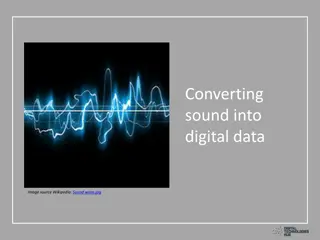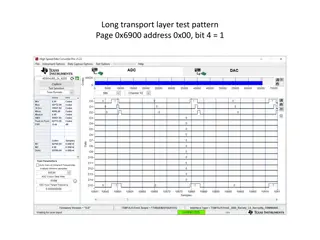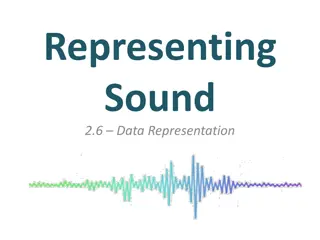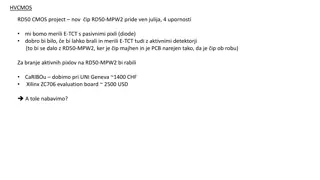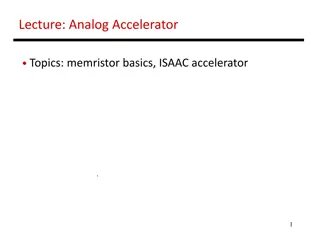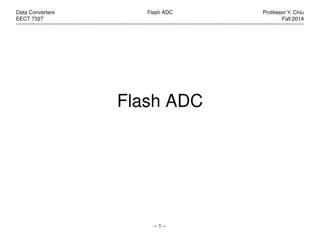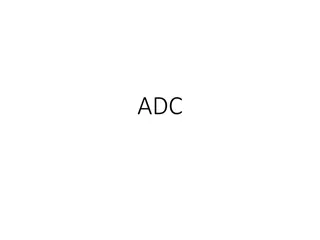
Analog to Digital Converters in Electronic Circuits
Explore the basics of Analog to Digital Converters in electronic circuits, including their significance, types, processes, and applications. Learn about the trade-offs, common types of ADCs, A/D processes, and practical examples of code-word calculations. Discover the essential role of ADCs in bridging the analog and digital worlds of signal processing.
Download Presentation

Please find below an Image/Link to download the presentation.
The content on the website is provided AS IS for your information and personal use only. It may not be sold, licensed, or shared on other websites without obtaining consent from the author. If you encounter any issues during the download, it is possible that the publisher has removed the file from their server.
You are allowed to download the files provided on this website for personal or commercial use, subject to the condition that they are used lawfully. All files are the property of their respective owners.
The content on the website is provided AS IS for your information and personal use only. It may not be sold, licensed, or shared on other websites without obtaining consent from the author.
E N D
Presentation Transcript
Electronic branch Fourth Class Interface Circuits Design Analog to Digital Converters Asst. Lec. Lubna A. Alnabi
Analog to Digital Converters What is an A/D Converter? What is the usual trade-off in A/Ds ? (ADC) are an electronic integrated circuit (IC) which transforms a signal from analog to digital form. The tradeoff between ADC groups are Accuracy and Speed
Analog to Digital Converters All microprocessors works with digital signal so ADC Provides a link between the analog and the digital worlds of signal processing. Why ADC is needed?
Analog to Digital Converters What are the most common types of ADC ? And how are they used? 1) The first group includes SAR, and converters. used as data loggers flash-type 2) The second group includes integrator and voltage to frequency converters. used as digital meter
Analog to Digital Converters What are the A/D processes? Sampling and Holding Quantizing and Encoding
Analog to Digital Converters What is sample and hold? It is a process of taking a sufficient number of discrete values at point on a waveform that will define the shape of waveform. What is Quantization and Encoding? Quantizing - is the process of converting the sampled continuous signals into discrete valued data Encoding - assigning a digital word or number to each state and matching it to the input signal.
For a 3 bit A/D, with Vmin=0 V, V max=10 V, what is the code-word for Vin=5.7 Volts?
For a 4 bit A/D, with Vmin=1 V, V max=9 V, what is the code-word for Vin=3.1 Volts? What is the quantization error AVG, and quantization error Max.
Analog to Digital Converters What is the resolution of an A/D? Resolution is the number of bits used for conversion (8 bits, 12 bits, )
Analog to Digital Converters How to increase the accuracy of A/D Conversion? Increasing the resolution Increasing the sampling rate
Flash A/D Converter What are the components of a Flash type A/D, draw the CCT? 1) Resistors use the resistors to form a ladder voltage divider 2) Comparators comparing input signal to reference voltage. 3) Priority encoder produces a binary output.
Find the code-word for a 3 bit, flash A/D with Vref=8V with Vin=5.6V. Vref N = 1 If Vin> Vref=1 else 0
Find the code-word for Vin=4.1V, and number of bits =3 with Vref=12V.
How Does a Flash type A/D work? 2- The voltage on the resistors is compared with Vin 1- Vref is divided over the resistors 3- The output of the comparator is fed to the priority encoder.
What are the components of a sigma-delta A/D, draw the CCT 1- Adder 2- Integrator 3- Comparator 4- D/A
Find the code-word for a 4 bit, sigma-delta A/D with Vref=2.5V with Vin=1.1V.
Find the code-word for a 5 bit, sigma-delta A/D with Vref=3.3V with Vin=2.7V.
How does the Dual Slope A/D work? 1- Control Logic switches to Vin and starts the counter. 2- Charging starts and lasts for Tch. 3- Control logic Switches to -Vref and restart the counter. 4- Discharge for Tdis until reaches the threshold and Enable output latch.
What are dual slope A/D Converter Components draw the CCT Integrator Electronically Cont Counter Clock Control Logic Comparator
What is SAR A/D Converter Components draw the CCT 1Comparator 2- SAR unit 3- DAC 4- Output Register
What are the components of a SAR A/D, sigma- delta A/D, Dual-slope A/D and a flash-type A/D?
Find the code-word for a 5 Bit SAR A/D with Vin=0.6V while Vref=1V. MSB (bit 5) Vref /2 If Vin > than Vref /2 , turn MSB on (1) If Vin < Vref /2 , turn MSB off (0) Vin =0.6V and V=0.5 Since Vin>V, MSB = 1 (on) 1
Next Calculate (bit 4) V=Vref/2 + Vref/4= 0.5+0.25 =0.75V Since Vin < 0.75, bit 4= 0 (bit 3) V=Vref/2(0.5) + Vref/8 =0.625 Since 0.6<0.625, MSB is turned off bit 3 = 0 (bit 2) V=Vref/2(0.5) + Vref/16 =0.5625 Since 0.6>0.5625 MSB is turned off bit 2 = 1 (bit 2) V=0.5625 + Vref/32 =0.59375 Since 0.6>0.59375 MSB is turned off bit 2 = 1 1 0 0 1 1
Conversion time is the time required to complete a conversion of the input signal, in other words it's the time it takes for an analog-to-digital conversion. Quantization error is defined as the difference between the actual analog input and the digital representation of that value. Ex: 1. An ADC has a conversion time of 100 s. what is the maximum frequency that can be converted? 2. A 1 Khz sinusoidal signal to be digitized using 8-bit ADC. Find the conversion time that can be used?
Ex: An 8-bits ADC is used to digitize a five volt (5v) full scale signal. What is the resolution? Maximum Quantization (qmax) Average Quantization (qav) Where A is the amplitude and n is the number of bits. Ex: An analog signal of amplitude 12v is sampled with an 8bit ADC; calculate the maximum and average quantization error?


